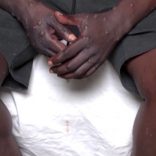Mozambique must improve climate change response
Mozambique: Life and death digging for gold in Namaíta, Nampula – Ikweli

Photo: Jornal Ikweli
It is estimated that about 20 miners, mostly young, lost their lives at dawn last Tuesday (13-10) due to the fury of the waters of the Meluli river, in the communities of Natchetche and Nacuaho, Namaita administrative post, Rapale district, Nampula province, northern Mozambique.
This was the place where, since last September, they had been extracting gold, one of the most valuable ores in the world.
Ikweli had warned about the alleged discovery of gold in the bed of the Meluli river in an article published on September 27. We reported at the time how the gold rush had attracted many people, the majority of them youngsters. They saw this place as the only means to appease the pain of poverty, a curse fed by the high rate of unemployment.
On the day of the tragic incident, it is estimated that more than 400 illegal gold miners were involved in extraction there, most of them from the Mogovolas district.
The first hours of last Tuesday (November 13) would be catastrophic for this group of young people and the communities of Natchetche and Nacuaho, in Namaita. According to what we learned, the fury of the water flooding the Meluli river swept up an unknown number of miners, with about 20 people losing their lives.
According to sources at the scene of the incident, it all started when some of the prospectors decided to sleep in caves in the riverbed. It was drizzling and this would be a way to stay dry during the night.
According to sources, it didn’t rain very heavily locally before the incident, so the victims had no reason not to trust their refuge, given that the bed of the Meluli river was dry at the time. In fact, they recall, it had never rained so much in October.
The water from the surrounding regions, where 117 mm of rain fell in five hours, swelled the Meluli river to levels never seen before in October, locals say.
“This all happened because we didn’t have a place to sleep, because ‘Colombia’ [the name of the local ‘garimpeiro’ settlement] is not covered,” Joaquim Eduardo, a surviving gold digger told Ikweli. “So when it started raining that night, we decided to go into the caves, to keep dry. There, we forgot all about it and slept until around midnight. That was when the water started to rise. At that time we were very sleepy. So, by the time we woke up we were disoriented, and that’s when some of us were swept away and drowned, and others were seriously injured.”
The administrative post of Namaita, specifically in the villages of Nacuaho and Natchetche, the area through which the Meluli river flows, is dominated by mountains. So much so that the riverbed of the Meluli there is surrounded by rocks of different dimensions and shapes. In fact, the amount of rocks along the riverbed is one of the reasons for the high number of casualties.
As of noon on Wednesday (October 14), government authorities, both at district and provincial level, still did not have an agreed number of victims, some talking about 13 dead and others, 16. Sources in the rescue teams estimate the number of fatalities at 20, and believe that there are still more bodies under the waters of the Meluli.
Read more: Mozambique: At least sixteen illegal gold miners die in Nampula – AIM report
Community leader in the village of Nacuaho Joaquim Mário expressed his sorrow over the incident, telling us that he had alerted the local government to the existence of the group, but that no intervention had been made.
“I tried to raise the awareness of the group, but we didn’t reach an understanding, so I referred the case on to the higher levels of our administrative post, who said they would hold a meeting this Wednesday (14). But this incident happened before that,” he said. “People were swept away by the water, so I again communicated about this event, and still now we are recovering bodies of lifeless people along this river,” he relates.
First camp was dismantled, set on fire
“It is very sad what happened. In principle, the search doesn’t end here. The community leaders, together with the local structure,s will continue, because as you know it is a large river with running water. Therefore, we have this situation which, unfortunately, happened after several calls that we had made. This is because this situation has been around for a month. Unfortunately, the first sensitisation was not accepted by the illegal miners. We held a second and, by the third time, we came to dismantle their camp,” Director of District Services for Economic Activities of Rapale Adelino Afonso Manuel explained.
After the removal of the first camp “they moved, and we were monitoring the situation. But what we didn’t know was that they went further upstream and hid behind the mountain while they continued gold mining in secret.”
Adelino Afonso Manuel confirms that there is gold along the bed of the Meluli river. “Yes, we can confirm that, what we do not confirm are the quantities. But we do confirm the occurrence of gold along the bed of the Meluli river. Now, it is up to the Provincial Directorate of Mineral Resources and Energy to find someone who can determine the quantity and then possibly move on to the subsequent steps, which are to maybe license someone maybe not. At the moment it is premature to say what will happen.”
Chief inspector in the Nampula Provincial Directorate for Mineral Resources and Energy (DPRME) Adelto Augusto Cumbana also confirmed the existence of gold ore in the Meluli river, in Namaita. But, seeing the conditions in the place, and perhaps influenced by the incident, he talks about the possibility of closing down the mining.
“The occurrence of gold is more than proven. People were doing this work because they were collecting gold. Notice how, after leaving the first camp, which we deactivated, they went up-river, mining along the way,” he says.
“What has been happening elsewhere is as follows: we assess conditions in the area so as to accurately advise [artisanal miners] communities whether to legally constitute themselves in order to be able to mine legally. And in this case, there are no conditions, because, firstly, it is in the riverbed, and secondly, in addition to the environmental damage that is caused in the river, there is no security for the miner himself,” he adds.
“We predicted such a situation, which is why when we heard about this [illegal miners working there], we didn’t even take steps to talk about the possibility of legalising the activity. The only thing we said is that that activity should never be carried out along the river. We are not able to legalise this activity, we are fighting with them, in the sense that, whenever we know where they are, we have to stop the activity,” Adelto Cumbana warns.
As a result of this prohibition, a team of inspectors from the DPRME in Nampula set fire to the miners’ huts [‘Colombia’] on the banks of the Meluli river in the Nacuaho area.
No less important is that, despite the incident, by Wednesday, a significant number of ‘garimpeiros’ were back on site, mining. When we asked them why they were still mining, despite the fact that the bodies of some of their colleagues had not yet been located, they said : “We can’t help but continue working because, as things stand, we have no money to return home. So we are trying to get the gold and sell it. Then, we will return home.”
Other miners interviewed by Ikweli even interpret the incident as a miraculous event which would pay the spirits enough for them to secure the proper authorisation of their gold digging activity.
By Constantino Henriques














Leave a Reply
Be the First to Comment!
You must be logged in to post a comment.
You must be logged in to post a comment.